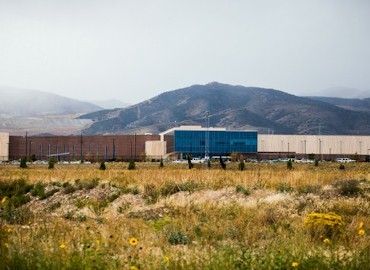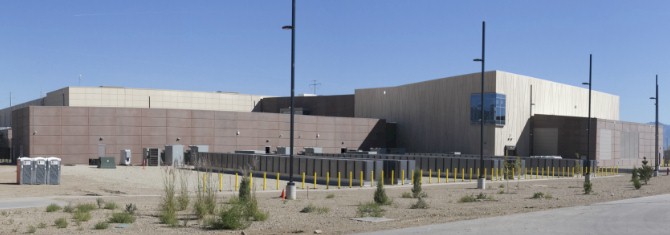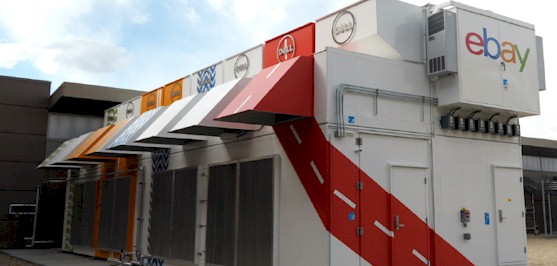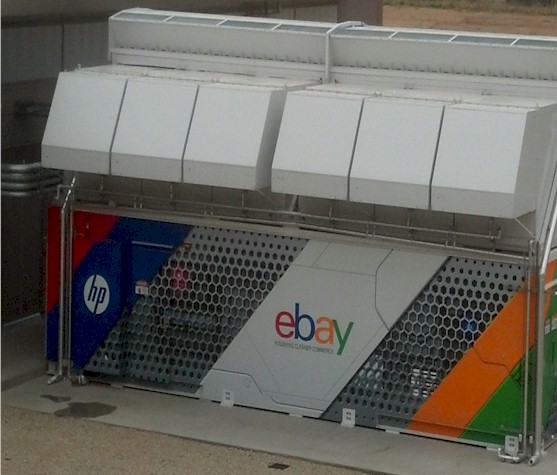eBay Juices Utah Modular Datacenter With Fuel Cells, Waste Heat

Online auctioneer eBay opened up the second phase of its datacenter outside of Salt Lake City, Utah, this week and has brought a number of new technologies to bear to increase the energy efficiency of its IT operations while at the same time reducing costs.
Based on the numbers, the current eBay datacenter in South Jordan, Utah is a pretty energy-efficient design. It hosts tens of thousands of servers and has a power draw for the IT equipment of 7.2 megawatts. (This does not include cooling and other power used by the datacenter, which gets its juice from the local electrical grid.) Phase one had a design goal of a power usage effectiveness (PUE) rating of 1.4. That is the ratio of the power coming into the data center divided by the power used by the equipment itself.
Dean Nelson, vice president of global foundation services at eBay, tells EnterpriseTech that the phase one data center exceeded that 1.4 PUE efficiency target. But, eBay wants to do better in phase two in its Utah center.
The datacenter expansion, nicknamed Quicksilver, looks a bit like an airport terminal, with a long corridor for humans to walk down the middle of; fuel cells from Bloom Energy hang off one side of the corridor and modular datacenters from Hewlett-Packard and Dell hang off the other side. It currently has 4.8 megawatts of power set up for the IT equipment, and the facility will be able to expand to 18 megawatts over time. The design goal here is a PUE of 1.2, and also to radically reduce the carbon footprint for the datacenter and cut costs at the same time.
eBay did a few things to get cleaner. First, it took a hard looked at the backup generators and uninterruptible power supplies that are in its other datacenters and decided to get rid of them. The problem with generators and UPSes, explains Nelson in this video, is that they are used only about 1 percent of the year, and usually when you have a bank of them, the exact moment when you turn them on – when there is a power failure in the electric grid – is when they fail.
"They are inherently risky, so you put a lot of redundancy in there to get rid of as much risk as you can. But they are extremely under-utilized pieces of equipment that cost tens of millions of dollars."
So eBay went to Bloom Energy, a NASA spinoff that makes fuel cells powered by natural gas and oxygen to create electricity. eBay has bought enough of Bloom's Energy Servers – love that term – to power up 6 megawatts of IT gear. At the moment, the electricity generated by the Energy Servers is being used by the older datacenters. Natural gas is pumped into the fuel cells by Questar, the local supplier in Utah. The natural gas pipeline is much more reliable than the combination of the electric grid, generators, and UPSes, so eBay's apps will stay online more. Here's what the fuel cell blocks look like:
That natural gas fuel cell setup is 49 percent cleaner than the coal-fired electric plants in Utah.
To lower its carbon footprint further, eBay has partnered with Ormat, which has created a system to convert waste heat back into electricity. It just so happens that the natural gas pumping station that is 22 miles away from the eBay data center in Utah has compressors that create a tremendous amount of waste heat. Enough, in fact, that eBay had them install equipment to recapture that heat and generate 5 megawatts of power. This electricity is pumped into the local electrical grid, which eBay is effectively using as a battery as it draws juice out of the grid 22 miles away to power the first phase of its data center.
When EnterpriseTech suggested that eBay might want to find its own gas wells the next time it builds a new datacenter, Nelson got a kick out of the idea, but suggested that the bigger opportunity was in those compressors. He said that there are over 1,200 such natural gas pumping stations in the country, and that is a lot of waste heat to convert into electricity.
The Quicksilver portion of eBay's Utah datacenter costs about half as much per megawatt of IT capacity as the first phase of the datacenter, a statistic that Nelson is also proud of. To be more energy efficient and to save capital and operational expenses is a tough trick to pull off.
On the IT side, eBay is contracting with HP and Dell for their modular datacenters. Here is the Dell EPIC Modular Data Center that eBay has chosen:
And this is what the HP EcoPOD modular datacenter looks like:
The Dell EPIC MDC has room for 24 racks of IT gear and can have up to 50 kilowatts of power in a rack without melting, for a total of 1.1 megawatts. It uses outside air cooling and has evaporative cooling (using misting water to chill the air) for when the outside temperature gets too high. Dell has filled up sixteen of those racks with gear already for eBay as part of the rollout.
The HP EcoPOD is currently empty, but with Meg Whitman being HP's CEO and a former CEO at eBay, you can bet that HP will get its turn to sell some iron to the online auctioneer. The HP modular datacenter is rated at 1.4 megawatts and can house 44 racks of IT gear with an extended-height 54U rack. That could be 4,224 of HP's SL230 server nodes from its Scalable Systems hyperscale server family or 19,800 nodes of its Moonshot microserver line.
With this design, the datacenter in South Jordan not only costs half as much per megawatt of power, but also is four times as dense.













